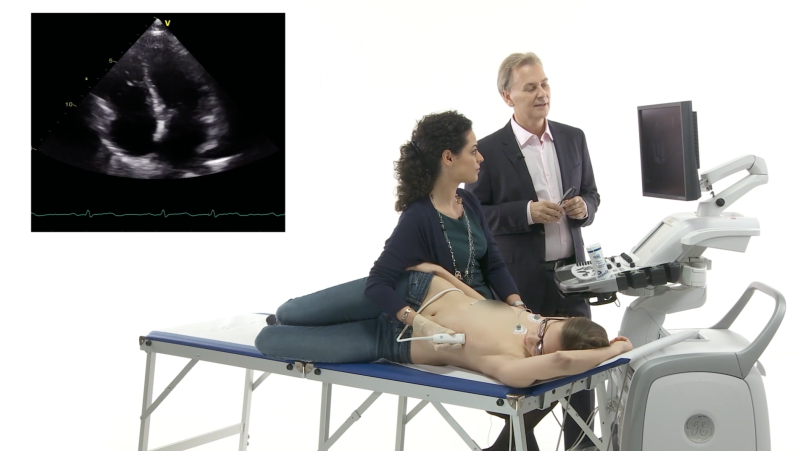A Conference And A Case
Today we have a conference announcement and a spectacular echo case for you. Let's start off with the conference ...
ASE 2012
The annual meeting of the American Society of Echocardiography is coming up again with lot's of great speakers and talks (June 30th to July 3rd, National Harbor, MD). We are going to be there as well and are looking forward to the learning experience. If you want to attend a world-class echo event, this is the place to be! Read all the way to the end of this e-mail to learn how you can meet us in person ...
A Case of Mass Destruction
- by Alexander Spiel and Hans Domanovits -

All of you practicing echocardiography know this situation: You put the transducer to the chest and you are absolutely astonished at what you see. You find something really “unusual”, “very large”, “more than severe” or “never seen before”. Such cases obviously fascinate. After all it is a fact of life that we are captivated by the bizarre. But such cases also have another twist to them: They are ideal to learn echocardiography!
Today’s case is the first of several cases that we will bring from time to time that deal with astonishing and unusual echoes.
The first case will also give us the opportunity to introduce you to the crew of our emergency department. They are the ones who are on the forefront of the bizarre and unusual, so they are also the right people to present this case. Here they are!
Enjoy!
yours Thomas

The ER Team, from left to right: Christian Waldmüller,
Andi Schober,Alexander Spiel and Hans Domanovits
Alexander & Hans enter the stage:
So here’s what happened
An 80 year-old man was transferred to our emergency department after out of hospital cardiac arrest. Cardiopulmonary resuscitation had initially been successful. He was in pretty bad shape: ventilated and severely hypotensive (pH 6.9, lactate 12.0mmol/l, BE -11.2mmol/l). Not a good prognosis. But what made things even worse was his echo.
Instant diagnosis
Here is an atypical parasternal long axis view:
We are sure you can immediately see what should NOT be there: a huge mass in front of the ascending aorta.
Large mass anterior to the ascending aorta. Video Platform Video Management Video Solutions Video Player The huge mass surrounds the ascending aorta and the great
vessels, which are slightly compressed.
Video Platform Video Management Video Solutions Video PlayerThe mass also extends caudally and can be seen anterior
to the right atrium.
Video Platform Video Management Video Solutions Video PlayerMoving the transducer to the right lung showed this image.
Once we recovered from our first astonishment, we went on to look at the mass more systematically.
Here are some of the features that describe the mass:
Very large, inhomogeneous, outside the heart or the pericardium, the origin is from the right of the thorax and no pericardial effusion is present.
Our first conclusion
The tumor is malignant for sure, of extra-cardiac location and does (as of now) not infiltrate the heart. To appreciate the full extent of the mass here is the spiral-CT of the chest:
 Spiral-CT shows a huge mass occupying the entire right
Spiral-CT shows a huge mass occupying the entire righthemi-thorax. The mass is inhomogeneous with areas
of necrosis visible. There is slight compression of the
superior vena cava.
Still some open questions
However, one question remains: Why did the patient have cardiac arrest? Well, there is one other important finding on the echocardiogram: did you catch it? The right ventricle was enlarged and the left ventricle had a “D shape” (see image above).
flattening of the inter-ventricular septum. Right ventricular
functionis reduced.
These findings suggest pulmonary embolism. And indeed CT confirmed massive pulmonary embolism (see arrow). This was certainly the cause for cardiac arrest.

Aside from the large mass, which encircles the great vessels,
there is also a thrombusin the left pulmonary artery.
What we learned
Well, you can imagine how the story ended, he passed away shortly after we performed this echo despite thrombolysis and all measures we could think of. As it turned out - the patient had been diagnosed with malignant myxofibrosarcoma several weeks ago. But what is the lesson? Sure, you can be fascinated by the impressive findings on an echo, but this does not mean that you should forget to perform a sound and thorough standard exam as well.
Some final thoughts on the conference
We hope this case will help you to treat your own patients! Now some more info on the ASE meeting and how you can meet us there ...

The folks at ASE have done an amazing job at putting together a wonderful program. One thing we are particularly looking forward to are the Networking Events:
President's Reception: Come celebrate ASE 2012 in the Exhibit & Poster Hall. Network with colleagues and friends while learning more about the newest equipment and services in the cardiovascular field. Complimentary hors d'oeuvres and cocktails will be available.
Appy Hour: This is a new event that combines mobile applications and networking. Learn how you can keep ASE guidelines and membership information at your fingertips while enjoying an opportunity to talk with your colleagues.
Independence Day Reception:Also new in 2012, Monday's afternoon break will consist of a farewell reception in the Exhibit & Poster Hall.
So if you would like to meet Thomas Binder at one of these events, please write an e-mail to office@123sonography.com and we'll arrange something.
Have a great day!
the 123sonography Team
Recommended articles:
The Cloud Forest of Echocardiography
Far From Home
Assessment of Masses Using Echocardiography


